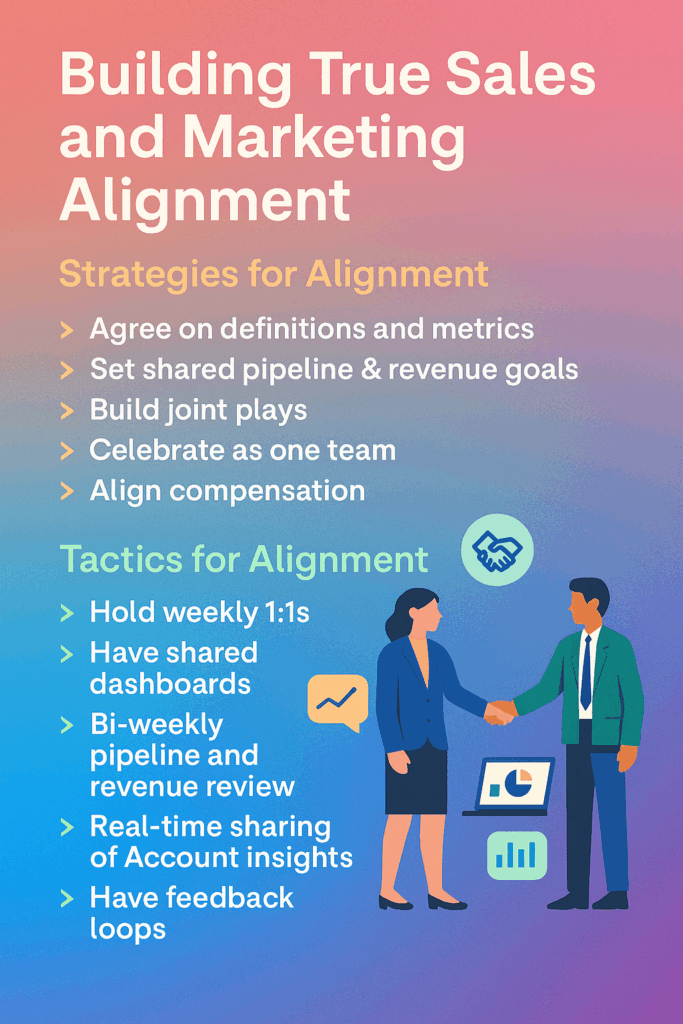Many marketing and sales leaders say they are “aligned.” It is a common talking point on platforms like LinkedIn.
But when you dig beneath the surface, much of that so-called alignment falls apart quickly.
True sales and marketing alignment is not about attending the same meetings.
It is about sharing ownership over accounts, pipeline, and revenue in a measurable way.
And nowhere is that need for true alignment more exposed than in account-based marketing (ABM).
ABM strategies make every crack between sales and marketing painfully visible—and if you are not genuinely aligned, you will not drive results.
Here’s how the best companies create real sales and marketing alignment to fuel go-to-market (GTM) success.

Why Sales and Marketing Alignment Matters More Than Ever
In traditional lead generation models, marketing and sales could function somewhat independently.
Marketing generated MQLs, tossed them over the fence, and sales decided whether to pursue them.
ABM demands a different model.
Sales and marketing must operate as a coordinated unit focused on the same target accounts, moving through the same stages, and measured by the same outcomes.
Without real alignment:
- Messaging becomes inconsistent
- Campaigns lack timing coordination
- Opportunities slip through the cracks
- Revenue growth slows or stalls
Companies that master alignment across their ABM motions are the ones dominating pipeline creation and closing larger deals faster in 2025.
Strategies for True Sales and Marketing Alignment
Achieving real alignment requires strategic groundwork. Here are five essential strategies for teams serious about aligning their GTM execution.
1. Agree on Definitions and Metrics
Alignment begins with clarity.
Sales and marketing must share a precise understanding of key terms and stages.
Questions every team should answer together:
- What qualifies an account as “engaged”?
- What exactly defines a “stage 1” or “stage 2” opportunity?
- What intent signals or behaviors matter most at each funnel stage?
Building shared definitions eliminates confusion and ensures both teams measure progress in the same way.
If your sales team and marketing team are not speaking the same language, true alignment is impossible.
2. Set Shared Pipeline and Revenue Goals
Success cannot be measured solely by marketing engagement metrics or sales quota attainment.
Both teams must jointly own:
- Pipeline targets from ABM accounts
- Closed-won revenue sourced or influenced by ABM
- Account engagement scores
When both sides have skin in the game, it reinforces the idea that wins and losses are collective, not siloed.
Shared accountability is the foundation of real sales and marketing alignment in ABM programs.
3. Build Joint Plays
ABM fails when marketing runs one playbook and sales runs another.
Successful companies design joint plays—coordinated sequences of messaging, content, outreach, and campaign activation.
Joint plays should:
- Align around buyer personas and buying stages
- Integrate both marketing touchpoints and sales activities
- Sequence messaging across channels and cadences
When marketing and sales execute coordinated plays, buyers experience a seamless, consistent journey rather than a fragmented one.
4. Celebrate Wins as One Team
Recognition drives behavior.
To reinforce alignment, celebrate pipeline wins and revenue achievements jointly.
Whether it is an account reaching a milestone engagement score or a deal closed from an ABM motion, recognition should:
- Include both sales and marketing contributors
- Reinforce shared ownership over results
- Highlight examples of successful collaboration
Building a culture of shared success strengthens alignment over time.
5. Align Compensation Models
You do not need identical comp plans for sales and marketing—but they should connect.
For example:
- Marketing compensation can include pipeline creation and influenced revenue targets
- Sales compensation can include metrics like marketing-sourced pipeline progress
When compensation models reflect shared business goals, behavior naturally aligns.
Compensation misalignment is often one of the biggest hidden barriers to true ABM success.
Tactics for Operationalizing Sales and Marketing Alignment
Strategies set the foundation, but tactics bring alignment to life daily.
Here are the tactical moves leading teams use to operationalize alignment across their GTM motion.
1. Hold Weekly 1:1s Between Sales and Marketing
Dedicated working sessions between key marketing and sales owners keep initiatives tightly coordinated.
Topics for weekly 1:1s include:
- Which accounts need marketing air cover?
- Where can marketing rewarm cold opportunities?
- Where is sales stuck in the buyer journey?
Regular tactical collaboration keeps momentum high and prevents misalignment from creeping in.
2. Create Shared Dashboards
Transparency builds trust.
Sales and marketing should have access to the same dashboards showing:
- Engagement by target account
- Pipeline progress by account stage
- Revenue attribution by campaign and motion
When everyone sees the same data, it is easier to diagnose problems, double down on successes, and stay focused on shared goals.
3. Conduct Bi-Weekly Pipeline and Revenue Reviews
Beyond individual 1:1s, bi-weekly cross-functional pipeline reviews allow broader pattern recognition.
During these sessions:
- Review forecasted pipeline from ABM accounts
- Discuss challenges in moving opportunities forward
- Align on next steps and necessary air cover from marketing
These meetings help prevent issues from festering and keep teams jointly accountable for progress.
4. Share Real-Time Account Insights
Marketing should feed sales real-time intelligence from ABM programs, such as:
- Intent signal spikes
- Content engagement by persona
- Buying group activity across touchpoints
Sales should give feedback immediately on:
- What messaging resonates
- Which signals led to productive conversations
- What new needs are emerging from buyers
Real-time insight sharing transforms static account plans into dynamic, buyer-driven campaigns.
5. Build Continuous Feedback Loops
A simple but structured system for feedback ensures ABM initiatives evolve with the buyer and market landscape.
Best practices include:
- Quick surveys post-campaign to gather sales feedback
- Quarterly feedback workshops between sales and marketing
- Integrating feedback loops into CRM or marketing automation platforms
Feedback loops ensure ABM programs stay relevant, agile, and closely aligned to what buyers actually want.
Alignment is an Ongoing Discipline
Building true sales and marketing alignment is not a one-time project.
It is an ongoing discipline that requires strategic foundations, tactical rigor, and cultural reinforcement.
In ABM, alignment is not optional.
It is the difference between building a thriving pipeline or wasting valuable budget on disconnected efforts.
Companies that master alignment between sales and marketing will lead the next generation of high-growth B2B organizations.
Those that treat it as lip service will be left behind.

Hi there! I’m Scott, and I am the principal consultant and thought leader behind Stratus Analytics. I have a Master of Science degree in marketing analytics, and I’ve have been providing freelance digital marketing services for over 20 years. Additionally, I have written several books on marketing which you can find here on Amazon or this website.
DISCLAIMER: Due to my work in the packaging industry, I cannot take on freelance clients within the packaging manufacturing space. I do not want to provide disservice to your vision or my employer. Thank you for understanding.
